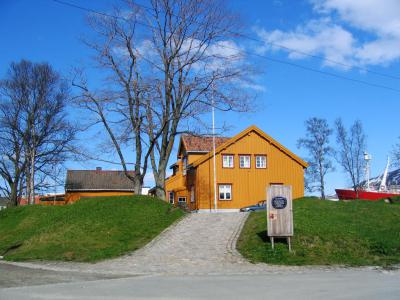Skansen, Tromso
Skansen, also known as Rundellen, stands as a significant fortification within the Norwegian city of Tromso. This ensemble of buildings holds the distinction of being the oldest in the city, with its fortress wall serving as the sole visible structure preserved from the Middle Ages. Designated as historical monuments since 1978, Skansen and a portion of the bay in the Tromsøysund Strait are revered for their historical significance. Moreover, Skansen was elected as the Millennium Site by the Tromso Municipality, symbolizing the transition into the 21st century.
Skansen is characterized by its circular fortress, situated atop an artificial plateau measuring approximately 50 meters in diameter. The fortress wall, standing three to four meters tall, features a gentle slope inward, with historical records suggesting it was once higher. Evidence suggests that palisades may have adorned the rampart for added protection, although this remains speculative. In 1808, four cannons were mounted on the eastern rampart, featuring carriages meticulously replicated from those found at Vardøhus Fortress.
Within the confines of the rampart, seven buildings exist, constructed between 1789 and 1793, though they do not originate from the same period as the fortress itself. The name Castle Hill hints at the possibility of a castle once occupying the site, as suggested by geologist Karl Pettersen in 1878. Similarly, Austrian Jesuit priest Maximilian Hell described Skansen as an ancient royal castle in 1769. The first written mention of Skansen dates back to 1743, documented by Major Peter Schnitler in a border protocol.
Skansen is characterized by its circular fortress, situated atop an artificial plateau measuring approximately 50 meters in diameter. The fortress wall, standing three to four meters tall, features a gentle slope inward, with historical records suggesting it was once higher. Evidence suggests that palisades may have adorned the rampart for added protection, although this remains speculative. In 1808, four cannons were mounted on the eastern rampart, featuring carriages meticulously replicated from those found at Vardøhus Fortress.
Within the confines of the rampart, seven buildings exist, constructed between 1789 and 1793, though they do not originate from the same period as the fortress itself. The name Castle Hill hints at the possibility of a castle once occupying the site, as suggested by geologist Karl Pettersen in 1878. Similarly, Austrian Jesuit priest Maximilian Hell described Skansen as an ancient royal castle in 1769. The first written mention of Skansen dates back to 1743, documented by Major Peter Schnitler in a border protocol.
Want to visit this sight? Check out these Self-Guided Walking Tours in Tromso. Alternatively, you can download the mobile app "GPSmyCity: Walks in 1K+ Cities" from Apple App Store or Google Play Store. The app turns your mobile device to a personal tour guide and it works offline, so no data plan is needed when traveling abroad.
Skansen on Map
Sight Name: Skansen
Sight Location: Tromso, Norway (See walking tours in Tromso)
Sight Type: Attraction/Landmark
Guide(s) Containing This Sight:
Sight Location: Tromso, Norway (See walking tours in Tromso)
Sight Type: Attraction/Landmark
Guide(s) Containing This Sight:
Walking Tours in Tromso, Norway
Create Your Own Walk in Tromso
Creating your own self-guided walk in Tromso is easy and fun. Choose the city attractions that you want to see and a walk route map will be created just for you. You can even set your hotel as the start point of the walk.
Tromso Introduction Walking Tour
The history of human habitation in this part of Scandinavia dates back to the end of the last ice age, some 9,000 to 10,000 years ago. The city of Tromso derives its name from the island of Tromsoya, on which it stands, whose own name, in turn, is likely associated with the word straumr, meaning "strong current."
A Viking chieftain named Ohthere, often referred to as the first North... view more
Tour Duration: 2 Hour(s)
Travel Distance: 2.3 Km or 1.4 Miles
A Viking chieftain named Ohthere, often referred to as the first North... view more
Tour Duration: 2 Hour(s)
Travel Distance: 2.3 Km or 1.4 Miles




